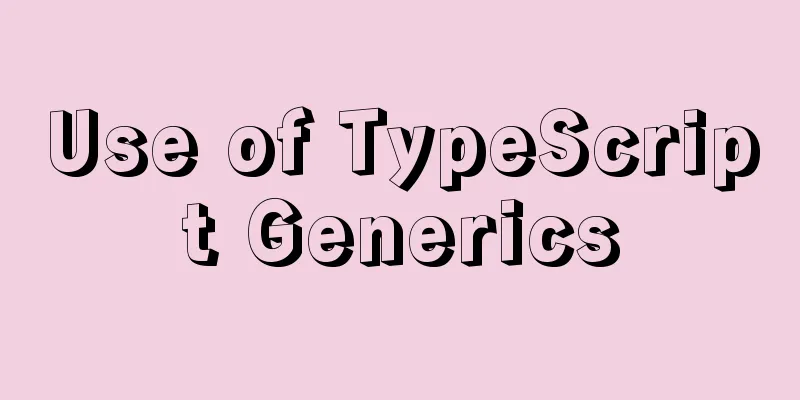Use of TypeScript Generics

|
Preface: In The emergence of TypeScript just solves this problem, but when considering the reuse of API, TypeScript does not seem to be so flexible. At this time, you can use the any type to solve the problem of inflexibility, but it returns to the problem in JavaScript, and the final result may not be what you expect. To solve this problem, 1. Easy to use Now we need to define a
// The so-called generics, in a more popular way, are types that are generally referred to. // Define a join function that accepts two parameters of the same type and returns the concatenated value.
function join<T>(first: T, second: T) {
return `${first}${second}`
}
// Here, T is specified as string typejoin<string>('第一', '第二') //第一第二// Here, through type inference, the compiler will automatically infer the type based on the passed parametersjoin(1, 2) // 12
Generics are defined using angle brackets <>. When we define the join function, we don't know what types can be accepted, but we can be sure that the two types must be the same. If we want to meet such a requirement, it is not so easy to solve it without generics. When calling a function, there are two ways to use it. One is to directly specify the type as string type; the other is to use type inference. The editor will automatically help us determine the type based on the passed in parameters. 2. Using generics in functionsWhen defining a function, we can use multiple generics, and the return value type can also be specified through generics, as long as the quantity and usage methods correspond. The sample code is as follows :
function identity<T, Y, P>(first: T, second: Y, third: P): Y {
return second
}
//Specified type identity<boolean, string, number>(true, 'string', 123) // string // Type inference identity('string', 123, true) // true
3. Using Generics in ClassesWe can use generics not only in functions but also in classes. The sample code is as follows:
class DataManager<T> {
// Define a class with a private array of type T constructor(private data: T[]) {}
// Get the value in the array based on the index getItem(index: number): T {
return this.data[index]
}
}
const data = new DataManager(['一碗周'])
data.getItem(0) // A bowl of ZhouMoreover, generics can also inherit from an interface. The sample code is as follows:
interface Item {
name: string
}
class DataManager<T extends Item> {
// Define a class with a private array of type T constructor(private data: T[]) {}
// Get the value in the array based on the index getItem(index: number): string {
return this.data[index].name
}
}
const data = new DataManager([{ name: '一碗周' }])
data.getItem(0) // A bowl of Zhou Use 4. Using type parameters in generic constraintsSuppose there is the following requirement: we define a class with a private object in it, which contains some properties; then we define a method to get the corresponding value through the key. The implementation code is as follows:
// Define an interface interface Person {
name: string
age: number
hobby: string
}
// Define a class class Me {
constructor(private info: Person) {}
getInfo(key: string) {
return this.info[key]
}
}
const me = new Me({
name: 'A bowl of Zhou',
age: 18,
hobby: 'coding',
})
// Calling me.getInfo() may result in an undefined value. For example, me.getInfo('myName') // undefined
In the above code, if we call the This problem can be solved by the keyof operator, which can be used to obtain all keys of a certain type, and its return type is a union type. The sample code is as follows: type myPerson = keyof Person // 'name' | 'age' | 'hobby' Now we can use this operator to solve the problem above. The sample code is as follows:
class Me {
constructor(private info: Person) {}
// This is the same as getInfo<T extends keyof Person>(key: T): Person[T] {
return this.info[key]
}
// getInfo<T extends 'name' | 'age' | 'hobby'>(key: T): Person[T] {
// return this.info[key]
// }
}
const me = new Me({
name: 'A bowl of Zhou',
age: 18,
hobby: 'coding',
})
// Calling me.getInfo() will result in a compilation error if an unknown property is passed me.getInfo('myName') // error: Argument of type '"myName"' is not assignable to parameter of type 'keyof Person'.
Now if we access a property that does not exist in the object, the compilation will be abnormal. This is the end of this article about the use of TypeScript generics. For more related TypeScript generics content, please search for previous articles on 123WORDPRESS.COM or continue to browse the related articles below. I hope everyone will support 123WORDPRESS.COM in the future! You may also be interested in:
|
<<: The difference and choice between datetime and timestamp in MySQL
>>: Summary of several commonly used CentOS7 images based on Docker
Recommend
CSS to achieve zoom in and out close button (example code)
This effect is most common on our browser page. L...
Summary of relevant knowledge points on how adaptive web design is achieved
How does "adaptive web design" work? It’...
JavaScript design pattern chain of responsibility pattern
Table of contents Overview Code Implementation Pa...
The concept of MySQL tablespace fragmentation and solutions to related problems
Table of contents background What is tablespace f...
How to Enable or Disable Linux Services Using chkconfig and systemctl Commands
This is an important (and wonderful) topic for Li...
Detailed explanation of the principles and usage examples of MySQL join query, union query, and subquery
This article uses examples to illustrate the prin...
MySQL8 Installer version graphic tutorial
Installation The required documents are provided ...
Detailed explanation of the solution to the problem of nohup log output being too large under Linux
Recently, I ran a spark streaming program in a ha...
Steps to set up Windows Server 2016 AD server (picture and text)
Introduction: AD is the abbreviation of Active Di...
The visual design path of the website should conform to user habits
Cooper talked about the user's visual path, w...
Detailed installation and use of docker-compose
Docker Compose is a Docker tool for defining and ...
Summary of English names of Chinese fonts
When using the font-family property in CSS to ref...
How to build a React project with Vite
Table of contents Preface Create a Vite project R...
MySQL 8.0.21.0 Community Edition Installation Tutorial (Detailed Illustrations)
1. Download MySQL Log in to the MySQL official we...
Webpack loads css files and its configuration method
webpack loads css files and its configuration Aft...









